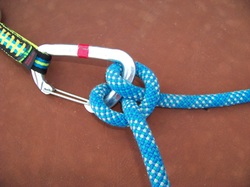The Clove Hitch
 Clove Hitch on a quickdraw
Applications: attaching yourself to an anchor, creating a carabiner block for a single-rope rappel, building anchors, attaching objects to the center of the rope
The Clove Hitch is a useful knot for attaching the middle of the rope to an anchor. It is quick and easy and will bear a significant load without sliding. It is a bit bulky and not as strong as other knots, so we also recommend learning the Figure Eight on a Bight for tying into anchors. We most commonly use the clove hitch to secure ourselves at the top of a climb instead of a personal anchor. The clove hitch is also useful if your belayer is knocked unconscious or otherwise out of commission. You can secure yourself quickly by tying a clove hitch to a biner attached to a bolt or piece of pro. You can also use the clove hitch to pass something up or down to your climbing partner when you are separated on a climb. The applications are numerous; learn to tie it, and you will use it often - especially when you start building anchors. How to Tie: Coil the rope twice to make two identical loops with the rope ("bunny ears"). Pass the closer of your loops behind the other. Clip your two loops into a carabiner and pull tight to set your knot. You can easily adjust a Clove Hitch by pulling the outer loop out, then pulling on either end of the rope. Watch the video below for a quick demonstration from Cristina. To learn how to tie the knot with one hand, check out our One-Handed Clove Hitch page. There is a more difficult way to tie a Clove Hitch which we won't demonstrate here, since it requires you to use the end of the rope and is probably not the right knot for the application anyway. It is more useful for sailing and other applications. |
|
